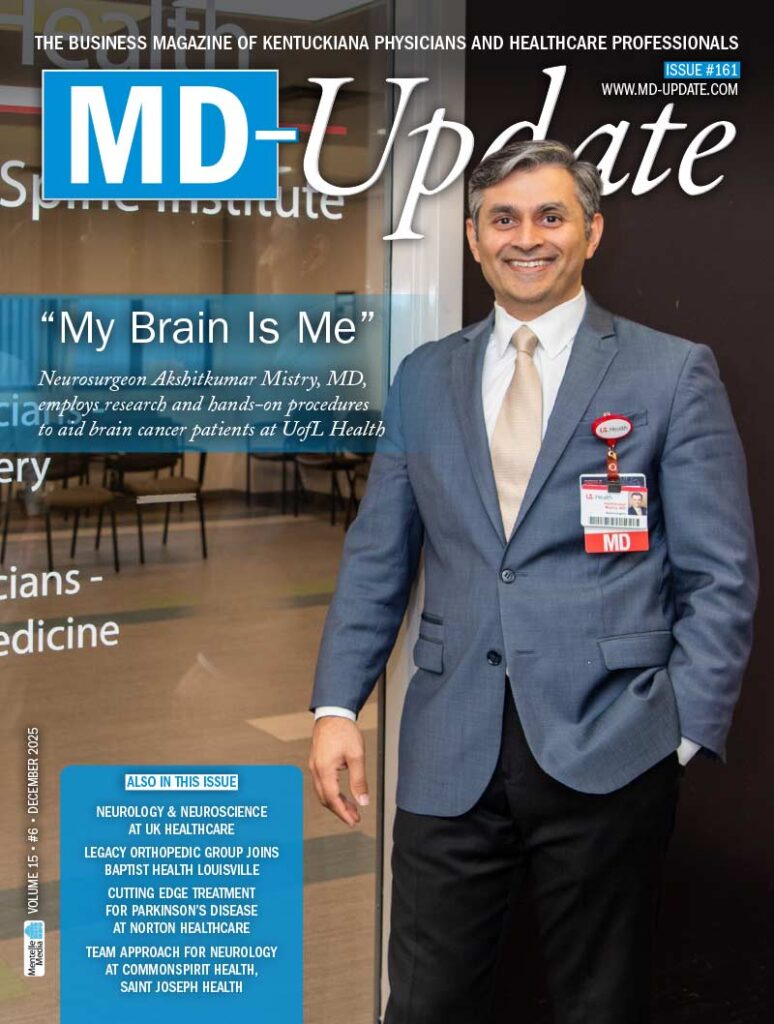
LEXINGTON Bodies were built to heal. This simple, yet profound statement is the cornerstone of Danesh Mazloomdoost, MD’s, practice. Mazloomdoost, an anesthesiologist and regenerative specialist, states, “Pain is simply a reflection of the body’s efforts to fix itself. The key is in figuring out what is inhibiting the body from repairing itself, and then facilitating that process.”
However, even within the medical community, there is much confusion and debate about pain and how to treat it. “In general, pain is not well understood. We equate pain with damage, and therefore absence of pain as absence of damage. While the former may be true, the latter is not. For example, steroids and anti-inflammatories may be helpful to quell the pain, but they can also suppress the healing process,” says Mazloomdoost.
To give Central Kentucky an alternative option from traditional pain evaluation and treatment, Mazloomdoost opened Wellward Regenerative Medicine.
What is Regenerative Medicine?
After a bachelor’s degree in medical economics and business management from Case Western Reserve University, Mazloomdoost received his medical degree from John Hopkins Medical Institute, where he also completed his anesthesiology residency. This was followed by pain medicine fellowships at the prestigious MD Anderson Cancer Center in Houston.
At Wellward Regenerative Medicine, Mazloomdoost’s responsibilities are trifold, balancing the roles of clinician, administrator, and innovator by bringing the latest advancements and revolutionary treatments into the clinic in a cost-effective way.
“Changing the way we view and treat pain is going to require a substantial culture shift in how healthcare addresses pain.”— Danesh Mazloomdoost, MD
Regenerative medicine, a relatively new field, focuses on how the body heals and how science can enhance this process, thus curbing the need for surgery and the use steroids and opioids. Mazloomdoost explains, “Pain management is great at understanding root causes of what hurts, but it is limited in facilitating its repair. By bridging that understanding with the cellular science of tissue regeneration, we can start facilitating how the body heals. This translates to less invasive treatments for many problems.”
He goes on to state, “I take a comprehensive look at the patient from the micro to macro scale. At the microscopic level, what is their cellular constitution for healing? For example, are they well-nourished and well hydrated? At the macroscopic level, what are their body mechanics and load distribution? Without taking such a comprehensive view, we are only providing short-term solutions and ignoring many opportunities to prevent problems rather than fix them.”

In order to successfully treat pain, you must first pinpoint the origin, which is “impossible to definitively diagnose through an x-ray or MRI.” So, at Wellward, they rely on pain mapping. According to Mazloomdoost, “Pain mapping is the process of using all the tools available in a singular session to map all the components of pain, from the mechanics of movement to the neural wiring and processing.”
He further explains, “Using ultrasound and fluoroscopy (live x-rays), for instance, we can visualize joints and ligaments, see how they perform under different stresses in real time. We can see how the region that hurts corresponds with loss of tissue integrity. We can test the function of these structures by injecting numbing medication around them and then repeat tests to see if the pain changes.”
The Road to Regeneration & Healing
Once thoroughly evaluated, treatment begins through regenerative techniques using prolotherapy, platelet-rich plasma (PRP), and stem cells to maximize the body’s natural healing responses. Specifically, these non-surgical injections stimulate the body to repair itself in areas of degeneration by the induced proliferation of new cells. They are used as a treatment of arthritis and pain throughout the body for a wide range of conditions, including chronic pain from injury, arthritis, spinal degeneration, instability and tears in ligaments, carpal tunnel syndrome, tennis elbow, plantar fasciitis, and a host of others.
When the injured areas are injected, a three-stage healing process begins. First is the inflammation stage in which macrophage and other inflammatory response cells prompt inflammation and increased blood flow. In the fibroblastic stage, fibroblast cells proliferate to repair the compromised tissue and secrete collagen, which strengthens the surrounding ligaments. The final maturation stage, in which the newly-formed tissue continues to mature, can last up to three years.
Wellward also employs multi-wave locked system (MLS) therapy, which treats pain, inflammation and arthritis through the use of infrared wavelengths to amplify regenerative processes. In addition to offering rapid pain relief by blocking pain transmission to the brain, it has anti-inflammatory benefits and can reduce scar tissue and lead to faster wound healing.
Other cutting-edge offerings include the Orgasm shot (O-shot) and Priapus shot (P-shot) which respectively use PRP to rejuvenate the female and male sexual organs increasing sexual health; the MedFit program designed to aid with vibrant aging; and ketamine infusion therapy.
“Depression, addiction, and pain all rely on one of the more primitive parts of the brain that is highly responsive by the receptors targeted with ketamine. It has applications for mood disorders, opioid dependency, opioid-induced hyperalgesia, chronic neuropathic pain, and other neural dysfunctions,” says Mazloomdoost.
Though he warns that ketamine therapy presents certain challenges such as a narrow therapeutic window and low oral bioavailability, he assures, “In a controlled environment with clinical expertise, it is very safe and extremely effective.”
Though these treatments are leading to a more open mindset, Mazloomdoost says, “Changing the way we view and treat pain is going to require a substantial culture shift in how healthcare addresses pain.”
But, part of Wellward Regenerative Medicine’s mission is to shift the pain and wellness paradigm. “Pain is complex, but a very basic understanding of it can help every clinician in addressing their patients and talking with them about realistic goals and treatment options. This is one of my clinical missions. We are establishing an auditorium in which we hope to educate clinicians and the community about better understanding pain.”



